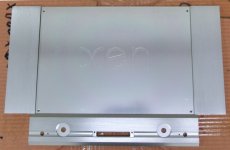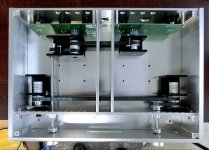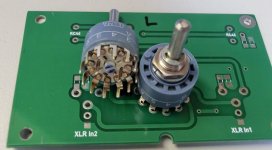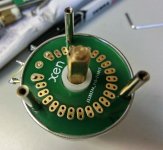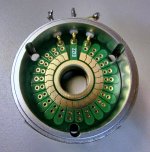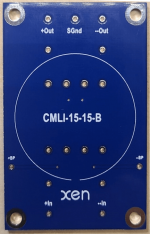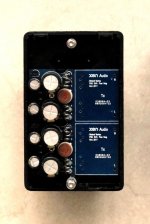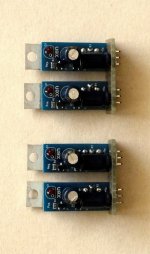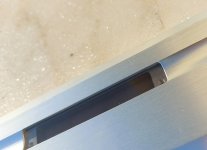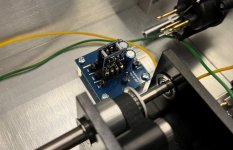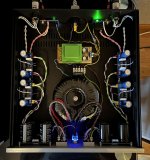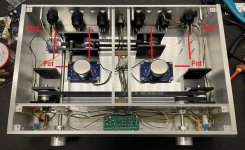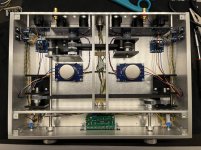The Pass B1 buffered passive preamp has been around for quite some time, and has been built many times around the globe.
What is missing is a balanced version of.
And even more difficult is to make it fully symmetrical (eletrically), i.e. truely dual mono.
Just search around in Google for balanced passive preamp, and you will realise.
We mentioned earlier that the guys in Hong Kong want to have a summer amp that does not dissipate too much.
There is already an example of a balanced LM4780 for that :
https://www.diyaudio.com/community/...approach-the-build-thread.208880/post-6271567
But he also wants a matching preamp to go with it.
Since the LM4780 itself has already enough gain, a passive preamp with discrete output buffers, a sort of a balanced DCB1, would be ideal.
So here is the result, even though not quite 100% finished.

Enjoy,
Patrick
.
What is missing is a balanced version of.
And even more difficult is to make it fully symmetrical (eletrically), i.e. truely dual mono.
Just search around in Google for balanced passive preamp, and you will realise.
We mentioned earlier that the guys in Hong Kong want to have a summer amp that does not dissipate too much.
There is already an example of a balanced LM4780 for that :
https://www.diyaudio.com/community/...approach-the-build-thread.208880/post-6271567
But he also wants a matching preamp to go with it.
Since the LM4780 itself has already enough gain, a passive preamp with discrete output buffers, a sort of a balanced DCB1, would be ideal.
So here is the result, even though not quite 100% finished.
Enjoy,
Patrick
.
Attachments
Last edited:
The symmetrical layout for the electronics is only made possible by complex mechanics inside the case.
The latter allows the seperate source selector switchs (Elma 01) and balanced potentiometers to be operated by one knob for each.
So here we demostrate how it can be done.
Patrick
.
The latter allows the seperate source selector switchs (Elma 01) and balanced potentiometers to be operated by one knob for each.
So here we demostrate how it can be done.
Patrick
.
Attachments
Last edited:
Each channel uses a "normal" stereo pot for volume control, avoiding 4-gang versions.
This is made possible by synchronising them with timing belts.
Any 6mm-shaft stereo pots can be used.
One option we like is the EIZZ switched attenuator.
But we don't like the carbon resistors inside.
So we made our own replacement PCB so as to be able to replace all resistors with Vishay Dales.
(Or anything size compatible, for that matter)
Patrick
.
This is made possible by synchronising them with timing belts.
Any 6mm-shaft stereo pots can be used.
One option we like is the EIZZ switched attenuator.
But we don't like the carbon resistors inside.
So we made our own replacement PCB so as to be able to replace all resistors with Vishay Dales.
(Or anything size compatible, for that matter)
Patrick
.
Attachments
For conversion of SE source to BAL, we also decided to go passive.
So this is done with a Cinemag CMLI-15-15 and using the two pots in series as output load.
For balanced sources, there is an option to bypass the Cinemag using a DPDT relay.
The relay is operated automatically when rotating the source selection knob.
And an additional push button allows the by-pass relay to be deactivated.
i.e. both SE and BAL signals will go through the Cinemag.
Patrick
.
So this is done with a Cinemag CMLI-15-15 and using the two pots in series as output load.
For balanced sources, there is an option to bypass the Cinemag using a DPDT relay.
The relay is operated automatically when rotating the source selection knob.
And an additional push button allows the by-pass relay to be deactivated.
i.e. both SE and BAL signals will go through the Cinemag.
Patrick
.
Attachments
As explained in the article, the discrete output buffers are powered by external wall warts, but with local discrete regulators.
There are different choices of buffers to suit all tastes, as they are all DIP( dual-opamp pin compatible.
And of course one can also use any DIP8 JFET-input dual opamp instead.
https://www.diyaudio.com/community/threads/b1-turbo-on-a-chip.140488/post-5740480
https://www.diyaudio.com/community/threads/b1-turbo-on-a-chip.140488/post-6775316
https://www.diyaudio.com/community/threads/b1-turbo-on-a-chip.140488/post-6847458
Patrick
.
There are different choices of buffers to suit all tastes, as they are all DIP( dual-opamp pin compatible.
And of course one can also use any DIP8 JFET-input dual opamp instead.
https://www.diyaudio.com/community/threads/b1-turbo-on-a-chip.140488/post-5740480
https://www.diyaudio.com/community/threads/b1-turbo-on-a-chip.140488/post-6775316
https://www.diyaudio.com/community/threads/b1-turbo-on-a-chip.140488/post-6847458
Patrick
.
Attachments
One of the users / builders has 4 ohm speakers.
Which is a bit heavy load for the LM4780 in bridged mode.
So it was decided to use 2x LM4780 in parallel to make up for that.
And of course the 4780 should also be Dual-Mono in layout (or shall we call it DM4780).
While still waiting for a proper case with internal heatsinks, here is a temporary solution with a commercial housing.
Patrick
.
Which is a bit heavy load for the LM4780 in bridged mode.
So it was decided to use 2x LM4780 in parallel to make up for that.
And of course the 4780 should also be Dual-Mono in layout (or shall we call it DM4780).
While still waiting for a proper case with internal heatsinks, here is a temporary solution with a commercial housing.
Patrick
.
Attachments
Hopefully, this has given you some inspirations for a "ideal" eletrical layout.
Made possible by appropriate use of mechanical transmissions.
Cheers,
Patricik
Made possible by appropriate use of mechanical transmissions.
Cheers,
Patricik
May I point out the short signal path and the wide separation between channels.
All the long wires are for the pre-reg power supplies.
The output buffers get discrete regulators mounted on the side wall (for optimum heat dissipation) right next to them.
And the loose wires are all temperary. They will all get twisted and properly clamped down in the end.
Patrick
.
All the long wires are for the pre-reg power supplies.
The output buffers get discrete regulators mounted on the side wall (for optimum heat dissipation) right next to them.
And the loose wires are all temperary. They will all get twisted and properly clamped down in the end.
Patrick
.
Attachments
Patrick,
How do you twist wires this tight in the amp, especially the transformer wires ?
When I twist 3 times looser that that, I get a spring effet that puts a lot of stress to the downward terminal...
How do you twist wires this tight in the amp, especially the transformer wires ?
When I twist 3 times looser that that, I get a spring effet that puts a lot of stress to the downward terminal...
Yes, that is really excellent craftmanship. Well done, attaining that level of attention to detail is something to aim for in future builds.
Kudos!
Kudos!
"How do you twist wires this tight in the amp, especially the transformer wires ?"
Easy to do if you use wires with some semi-hard insulation, such as Teflon.
Also litze with not so many strands, e.g. 7x.
Patrick
Easy to do if you use wires with some semi-hard insulation, such as Teflon.
Also litze with not so many strands, e.g. 7x.
Patrick
That is odd no constructors maked dual mono pot in line to avoid balance pot or complicate belt.
In a Dual in line with clics to lock the off set position between channels you should have just to turn the whole pot in line for choosing your spl volume without changing this offset. If the offset has to be change, do it with the two hands by setuping a new offset between the two in line pots.
Crazy Elna, swiss precision makers, TKD, etc didn't make this for high end...
In a Dual in line with clics to lock the off set position between channels you should have just to turn the whole pot in line for choosing your spl volume without changing this offset. If the offset has to be change, do it with the two hands by setuping a new offset between the two in line pots.
Crazy Elna, swiss precision makers, TKD, etc didn't make this for high end...
We don't like the stock carbon resistors.
So we change them to metal film of choice.
Also much tighter matching tolerances.
Patrick
So we change them to metal film of choice.
Also much tighter matching tolerances.
Patrick
- Home
- Amplifiers
- Pass Labs
- NoQuiPas -- A Truely Dual-Mono, Fully-Differential Passive Preamp with Output Buffers
